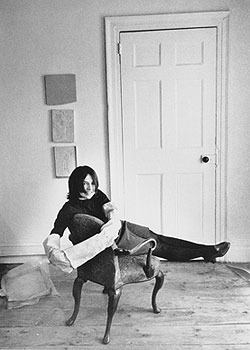Excellence (Still) Has No Sex: A Tribute To Artist Eva Hesse, 1936 – 1970
Published on March 30th, 2011 in: Art, Back Off Man I'm A Feminist, Feminism, Issues |By Emily Carney
“You won’t believe it. I was told by the doctor that I have the most incredible life he ever heard. Have you got tissues? It’s not a little thing to have a brain tumor at thirty-three.”

Eva Hesse
This was just the beginning of an interview artist Eva Hesse conducted with Cindy Nesmer near the end of her life. The tumult—and ultimate artistic triumph—of Eva Hesse’s inner life was more than apparent in the three-dimensional latex and plastic sculptures which she made near her life’s end.
Eva Hesse was born in Germany to a Jewish family in 1936; this twist of fate would have massive repercussions upon her life, as she was put on a train to Holland with her older sister during a pogrom in 1938. Germany had already been taken over by the Nazis, and all Jewish people—including children—were fair game. Eva and her family, amazingly enough, managed to survive this horrific transgression.
Her family eventually made it to the US in 1939, but the traumatic quality of her childhood didn’t end there: Her mother, a manic-depressive, committed suicide, and her father remarried a woman who was characterized hilariously by Eva as a “thorough, unadulterated bitch.” Eva’s relationship with her father became dangerously triangulated due to her hostile stepmother, and she developed intense abandonment issues. She turned her troubles inward, and concentrated on an intense interest in drawing and painting.
As a teenager in the 1950s, Eva secured an internship at Seventeen magazine, and went to Yale to pursue her artistic interests. Much of her early work extended to sketches and painting. She was a very successful art student, but reported that she felt like a “fraud” (no doubt due to her previous traumas). As a young woman, she married fellow artist Tom Doyle; this marriage was not successful, which created further abandonment issues for Eva.

Accession II, 1967 – 1969
Following the end of her marriage, Eva began to focus solely upon making three-dimensional latex and plastic sculptures. She abandoned drawing and painting completely. Many of her “box” sculptures (such as Accession II, 1967 – 1969) have a spiky, tactile quality. The viewer wants to reach out and physically touch the pieces. Her choice in using latex in making many of her hanging sculptures (such as Contingent, 1969) remains baffling in that the material tends to degrade over time. As a result, many of Eva’s latex-based sculptures are in fragile condition, or have decayed. Then again, perhaps this was her intention, to have these pieces remain temporary and fleeting, very much like a person’s lifetime.
Around 1969, Eva became inexplicably ill with strange symptoms such as nausea and vomiting, but brushed them off until an eventual collapse later in the year. Upon her collapse, it was discovered that she had a brain tumor that exacted a huge amount of pressure in her skull. After she awoke from her first brain surgery (probably even less of a “fun” experience in 1969), she discovered that if she hadn’t had the surgery, she would’ve been dead in a matter of hours.
At the time it was believed that her surgery was wholly successful; however, she had to undergo a few follow-up surgeries. When she awoke from one of the surgeries, Eva had a dream-like reverie in which she imagined herself working with film. She was a big fan of directors such as Godard. While Eva continued to work on her remaining unfinished pieces, she ultimately was too ill to realize her dream of doing film pieces. In early 1970 she was admitted to the hospital again for a recurrence of symptoms, and by May 1970, she was dead.
Like many female artists or writers who died young in the 1960s and 1970s (either by illness or by their own hand), Eva Hesse’s life as an artist, to some degree, is enmeshed with the grimy, painful details of her life (and death). However, Eva’s work has undergone a well-deserved popular and critical resurgence in the last decade; the interest in her work is similar to that of an artist who is still very much alive. Despite having a career spanning merely a decade (and which was mercilessly cut short by illness), Eva Hesse still proves that “excellence has no sex” (this was an actual quote from Eva’s diaries). The quality of her work continues to speak volumes in spite of the absence of the artist.
Sources:
Nixon Mignon and Cindy Nesmer, Eva Hesse (Massachusetts Institute of Technology, 2002).
To find galleries which exhibit Eva Hesse’s artwork, please visit the website of her estate.
Time limit is exhausted. Please reload the CAPTCHA.